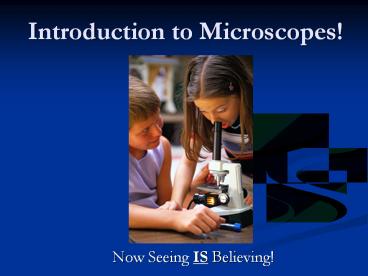Introduction to Microscopes! - PowerPoint PPT Presentation
Title:
Introduction to Microscopes!
Description:
Introduction to Microscopes! Now Seeing IS Believing! A Brief History Simple Glass Magnifiers More than 500 years ago. In 1600s, this simple microscope allowed ... – PowerPoint PPT presentation
Number of Views:174
Avg rating:3.0/5.0
Title: Introduction to Microscopes!
1
Introduction to Microscopes!
- Now Seeing IS Believing!
2
A Brief History
3
Simple Glass Magnifiers
- More than 500 years ago.
- In 1600s, this simple microscope allowed
scientists to see cells and bacteria - Problem not enough
magnification
4
First Compound Microscope
- Developed at the beginning of the 1600's, by the
Janssen brothers and Galileo - Problem images
were blurred and
had
colored halos
5
(No Transcript)
6
(No Transcript)
7
Simple Compound Microscope
- Invented in 1660s
- Problem all images had red or blue halos
around them
8
(No Transcript)
9
(No Transcript)
10
(No Transcript)
11
Even better!
- 1700 and 1800s great improvement in microscopes
- Usually made of brass (expensive)
- Had a tripod for support
12
(No Transcript)
13
(No Transcript)
14
Modern Compound Microscope
- 1900s, started using iron
instead of brass (cheaper) - Only one eyepiece
(monocular) - Outside light source
reflected onto mirror - Very functional
- Still used today
15
Fancy!
- Better images
- More magnification
- Better lighting
- Easier to use
- Now everyone, at one time or another, has looked
through a microscope
16
How Does It Work?
- A microscope works very much like a telescope.
- A telescope must gather light from a dim, far
away object. - So, it needs a large
objective lens
to
gather as much light
as possible and a
long body to bring
the image into focus.
17
How Does It Work?
- Unlike a telescope, a microscope must gather
light from a tiny specimen that is close-by. - So the microscope does not need a large objective
lens. - Instead, the objective lens of a microscope is
small. - Then the image is again magnified by a second
lens, called an eyepiece, as it is brought to
your eye.
18
Parts of a Compound Microscope
So EASY a KID could use it!
19
Base
- The bottom of the microscope, used for support
- Hold this part with one hand when carrying a
microscope
?
20
Mirror
- Reflects the light so the specimen is easier to
see
?
21
Stage
- The flat platform where you place your slides.
- It has a hole in it so light can shine through
?
22
Clip
- Shiny clips on the top of the stage
- Holds a slide in place
?
23
Arm
- Supports the tube and connects it to the base
- The part you hold when you carry the microscope
?
24
Coarse Adjustment
- Large, round knob on the side of the microscope
- Either moves the stage or the top part of the
microscope up and down
?
25
Fine Adjustment
- Small, round knob on the side of the microscope
- Used to fine tune the focus after using the
coarse adjustment knob.
?
26
Eyepiece
?
- The lens at the top that you look through.
- 10X power
27
Body Tube
- The long tube that holds the eyepiece and
connects the objective
?
28
Nosepiece
- Rotating part of the microscope at the bottom of
the body tube. - It holds the objective lenses
?
29
(No Transcript)
30
(No Transcript)
31
(No Transcript)
32
(No Transcript)
33
(No Transcript)
34
High Power Objective
- The longest objective lens
- The highest magnification
- 40X lens (40X x 10X 400X
magnification)
?
35
Low Power Objective
- The shortest objective lens
- The lowest magnification
- 4X lens (4X x 10X 40X
magnification)
?
36
Mid Power Objective
- The medium length objective lens
- The medium magnification
- 10X lens (10X x 10X 100X
magnification)
?
37
Diaphragm
- Controls the amount of light going through the
hole in the stage
?
38
Pop Quiz
- What two parts should you hold when you carry a
microscope? - Base Arm
- Where do you put a slide?
- On the Stage
- To focus, what knob do you turn first? Second?
- First, Coarse Adjustment
- Second, Fine Adjustment
?
?
?
?
?
39
Test Your Skills . . .
- Arm
- Body Tube
- Stage
- Clip
- Base
- Coarse Adjustment
- Fine Adjustment
40
Test Your Skills
- High Power Objective
- Low Power Objective
- Mirror
- Eyepiece
- Nosepiece
- Diaphragm
41
- http//www.udel.edu/biology/ketcham/microscope/tes
tFLV8.html - http//www.wisc-online.com/objects/index_tj.asp?ob
jIDBIO905































